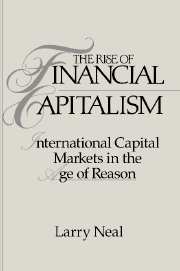Book contents
- Frontmatter
- Contents
- Acknowledgments
- 1 Historical background for the rise of financial capitalism: commercial revolution, rise of nation-states, and capital markets
- 2 The development of an information network and the international capital market of London and Amsterdam
- 3 The early capital markets of London and Amsterdam
- 4 The Banque Royale and the South Sea Company: how the bubbles began
- 5 The Bank of England and the South Sea Company: how the bubbles ended
- 6 The English and Dutch East Indies companies: how the East was won
- 7 The integration of the English and Dutch capital markets in peace and war
- 8 The English and Dutch capital markets in panics
- 9 The capital markets during revolutions, war, and peace
- 10 A tale of two revolutions: international capital flows, 1792–1815
- 11 The Amsterdam and London stock markets, 1800–25
- Appendix End-of-month share prices
- Bibliography
- Index
7 - The integration of the English and Dutch capital markets in peace and war
Published online by Cambridge University Press: 25 March 2010
- Frontmatter
- Contents
- Acknowledgments
- 1 Historical background for the rise of financial capitalism: commercial revolution, rise of nation-states, and capital markets
- 2 The development of an information network and the international capital market of London and Amsterdam
- 3 The early capital markets of London and Amsterdam
- 4 The Banque Royale and the South Sea Company: how the bubbles began
- 5 The Bank of England and the South Sea Company: how the bubbles ended
- 6 The English and Dutch East Indies companies: how the East was won
- 7 The integration of the English and Dutch capital markets in peace and war
- 8 The English and Dutch capital markets in panics
- 9 The capital markets during revolutions, war, and peace
- 10 A tale of two revolutions: international capital flows, 1792–1815
- 11 The Amsterdam and London stock markets, 1800–25
- Appendix End-of-month share prices
- Bibliography
- Index
Summary
The preceding chapters have described a special form of economic integration that occurred in the first quarter of the eighteenth century between Europe's two leading mercantile cities: Amsterdam and London. An international capital market developed that led to increasingly wider-ranging capital markets for each center over the succeeding centuries. It also would have facilitated the progress of economic integration for northwestern Europe in terms of markets in goods and labor, had it not been for its use in the service of the rising nation-states and their exercise of national power. That early international capital market, however, seems to have been treated by historians mainly as an economic curiosity, largely because its operations have been viewed from the perspective of a particular center or nation, never as a whole. This chapter lays the basis for a greater appreciation of the international dimensions of financial capital in the eighteenth century by examining the operations of the London and Amsterdam stock markets in theoretical terms and analyzing the results in quantitative terms.
Shares of the great chartered joint-stock corporations in England were traded simultaneously on the stock exchanges of London and Amsterdam at least by the summer of 1723. We know this from the Amsterdamsche Courant, which began giving prices of English shares on the Amsterdam Beurs in its issue of 9 August 1723. However, we know also that trade in the shares of the Dutch East and West India companies was active from their foundation in the seventeenth century, but the Courant began reporting the prices only in its issue of 14 July 1723. So trade in English shares on the Amsterdam exchange probably occurred earlier as well.
- Type
- Chapter
- Information
- The Rise of Financial CapitalismInternational Capital Markets in the Age of Reason, pp. 141 - 165Publisher: Cambridge University PressPrint publication year: 1991



